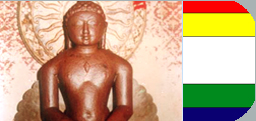
|
||||||||
|
Jainism History Bhagwan Mahavir said, "If you kill someone, it is yourself you kill. If you overpower someone, it is yourself you overpower. If you torment some one, it is yourself you torment. If you harm someone, it is yourself you harm." A wise man knows this and so he does not kill, nor does he overpower or torment anyone. Background Lord Mahavir's preaching was orally complied by his disciples into many texts. This knowledge was orally transferred from acharyas (gurus) to the disciples over the course of about one thousand years. In olden times, monks strictly followed the five great vows of Jainism. Even religious scriptures were considered possessions and therefore knowledge of the religion was never documented. Also, during the course of time many learned acharyas (elder monks) complied commentaries on the various subjects of the Jain religion. Around 500 A.D., which was one thousand years after Lord Mahavir's nirvana (death), Jain acharyas realized that it was extremely difficult to keep memorizing the entire Jain literature complied by the many scholars of the past and present. In fact, significant knowledge was already lost and the rest was polluted with modifications and errors. Hence, they decided to document the Jain literature as known to them. In this time period two major sects, namely Digambar and Swetambar, were already in existence. A thousand years later (1500 A.D.), the Swetambar sect divided into three subsects known as Swetambar Murtipujak, Sthanakvasi, and Terapanthi. Differences exist among these sects in their acceptance of the validity of the documented Jain scriptures and literature. Agam Literature |
||||||||
|
|

 |
| Every soul is divine and has the potential to achieve God-consciousness. Any soul which has conquered its own inner enemies and achieved the state of supreme being is called “jina” more.... |
There is no overarching supreme being, divine creator, owner, preserver or destroyer. Every living soul is potentially divine and the Siddhas, those who have completely eliminated their karmic bonds to end their cycle of birth and death, have attained God-consciousness. |
Sammed Shikharji Girnarji Mahavirji Mangi Tungi Shatrunjaygiri Palitana Kundalgiri Mahuaji more.... |
 |
Jiyo Aur Jine Do..... (Mahavir Bhagwan) | |
 |
Bhagwan Rishabha (Adinath) Ji Bhagwan Ajitnath Ji Bhagwan Sambhav Nath Ji Bhagwan Abhinandan-Nath Ji Bhagwan Sumatinath Ji Bhagwan Padmaprabha Ji Bhagwan Suparshvanath Ji Bhagwan Chandra-Prabha Ji |
Bhagwan Pushpadanta Ji Bhagwan Shitalnath Ji Bhagwan Shreyamsanath Ji Bhagwan Vasupujya Ji Bhagwan Vimalnath Ji Bhagwan Anantanath Ji Bhagwan Dharmanath Ji Bhagwan Shantinath Ji |
Bhagwan Kunthunath Ji Bhagwan Aranath Ji Bhagwan Malinath Ji Bhagwan Munisuvrata Ji Bhagwan Naminath Ji Bhagwan Neminath Ji Bhagwan Parshvanath Ji Bhagwan Mahavira Ji |



